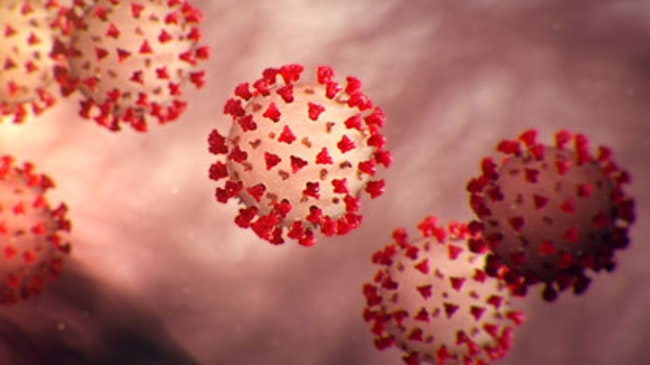
Local cases of the Covid virus are growing but no single source has been identified as the cause of the mini-surge in infections. (CDC file art)
ONTARIO – Malheur County can’t identify the source for nearly half the recent Covid infections, underscoring how far the virus has infiltrated into the community and creating a tougher challenge for health officials as they scramble to stop a growing outbreak.
A surge in local Covid cases kicked off in mid-June when the county reported 43 cases. From there, cases began to steadily rise and climbed to 60 by June 24, and then hit 108 Monday.
Of those 108 infected individuals, 41 people have recovered. The health department has completed 1,502 tests. The largest number of cases are in the 20-29 age group, according to the health department.
The rapid burst of Covid cases pushed the county past several key, state benchmarks used to measure the success of reopening plans.
The state officials said Monday they planned to meet with county authorities to review the changed circumstances.
Four factors may be driving the recent uptick in local cases, said Sarah Poe, Malheur County Health Department director.
Poe said individual behaviors, the total number of people in the Treasure Valley, a seamless border between Oregon and Idaho and reopening the county may all be contributing to the recent rise in cases.
“We are concerned about reports of large gatherings, especially indoors with people not wearing face coverings and not maintaining social distance,” said Poe.
Poe said the county experienced an uptick in cases after Memorial Day and that “we are definitely concerned about he upcoming Fourth of July holiday.”
“We hope people would stay locally and move any gatherings outdoors,” said Poe.
Poe also noted that Malheur County doesn’t exist in a vacuum regarding Covid.
The county is linked with Ada, Canyon, Payette and Washington counties in Idaho where the rate of Covid cases continues to accelerate.
“We are in the same larger community spread,” said Poe. “We are up against Canyon, Washington and Payette counties. We are seeing significant rise there,” said Poe.
The more people live in a specific geographic area, the larger the risk from Covid, said Poe. Malheur County hosts people from Idaho coming to work and shop every day, she said, and that elevates the risk.
“The number of people who are in Malheur County every day is significantly higher than other Oregon counties that border us,” said Poe. The virus is spreading throughout the county – dubbed community spread – which means there is no source yet identified for many of the new cases. Such cases happen when an infected person passes the virus to someone else when they don’t know that they are themselves infected. That means health officials have a harder time tracing who might have been in contact with an infected individual. Such tracing is easier when an outbreak is traced to a single location such as a particular factory or office.
Poe said the community needs to take the developing cases seriously.
“If our community reacts quickly and goes about daily life as though the coronavirus could potentially be around you, that is the only way we can flatten the curve. We are at a high risk of a large outbreak,” said Poe.
Over the weekend Idaho reported at total of 5,350 Covid cases and 91 deaths. Oregon reported 8,348 Covid cases with 204 deaths Sunday.
Poe said she isn’t ready to label the new Malheur County infections an outbreak but said the rising numbers are “a real warning sign.”
Gov. Kate Brown over the weekend said new shutdowns might be in order if the state’s infection rate rows. She backed up her concerns Monday by announcing a new statewide mandate that anyone going into a public place must wear a mask. Her new order is effective Wednesday, July 1.
“I do not want to have to close down businesses again like other state are now doing. If you want your local shops and restaurants to stay open, then wear a face covering when out in public,” said Brown in her Monday statement.
Managing risk
The virus, said Poe, is firmly established in Malheur County. That means, she said, local residents should follow social distancing guidelines and other measures – such as wearing a face mask – when outside of their homes.
Poe said residents must evaluate their personal risk when they venture out.
“Whenever you leave your home you are taking a risk. That risk can be weighed and measured and impacted by our behavior,” said Poe.
Poe said the biggest Covid risk for residents is close, person-to-person contact over an extended period of time indoors.
Prolonged exposure to many different people in the community is also risky, said Poe.
“The more people you are around there is a higher potential people would be infected,” said Poe.
Random contact – such as passing a person in the grocery store aisle – isn’t high risk, said Poe, especially if a mask is worn.
Still, she said, the danger of contracting the virus is never zero.
“It is all relative,” said Poe. She said the county is trying to “give people the opportunity to make decisions and be active in public life.”
“But if businesses are to reopen the only way we can do that safely is if people are following the precautions,” said Poe.
For example, she said, when visiting a local restaurant, residents should “wear a face covering the entire time until you are seated and ready to eat. You’d wear a face covering on the street or going into the building and when you are waiting for a table.”
Why percentages matter
As the number of Covid tests in Malheur County has climbed, so has the percentage of tests coming back positive. That rate is an important gauge for health officials as they weigh the total impact of the virus locally.
The percentage of positive tests climbed from 3.8% June 14 to 7% Sunday.
The dilemma for local health officials is that for weeks testing focused on people with active symptoms or who were in a high-risk category, such as the elderly or people with underlying health conditions.
That meant, said Poe, the likelihood of getting a positive test was higher. The health department, though, lowered its testing threshold last month to include a wider range of people and age groups, which should have meant the rate of positive tests should be going down in the county.
“We are now testing people who just had exposure or testing people who are in disproportionally affected groups and people with mild symptoms. So, we are testing lots of people who probably don’t have the virus. So, with more tests, a smaller percentage of those tests would be positive,” said Poe.
That isn’t happening, though.
“The concern is we are testing a lot of people who we’d anticipate being negative and our percentage keeps increasing,” said Poe.
The result is somber, she said.
“That is telling us it is just not increased testing that is finding these cases but the result of the virus spreading,” said Poe.
The virus is also hitting specific ethnic groups hard across the state and locally.
State data from last week showed a definite hike in the number of cases per 10,000 among Blacks, American Indians, Pacific Islanders, and Hispanics.
The rate of infection among Hispanics across Oregon stood at 37 per 10,0000 people. For whites, it was 7 per 10,000.
The local Covid rate among ethnic groups isn’t publicly available, said Poe.
“Smaller counties need to be careful about releasing data that could be used to stigmatize or make it seem like our cases are somehow isolated to one specific population or town because that’s not true,” said Poe.
Poe said, however, county data on Covid among ethnic groups is “very similar to the state’s.”
“Communities across the nation that have larger Hispanic populations and people of color have been disproportionally affected by the virus,” said Poe.
That is partly because, she said, of economics.
“They often have jobs that are essential, lack health insurance and easy access to health care,” said Poe. The county is already over the limits set by the state in May to allow for reopening. The Oregon Health Authority then listed benchmarks “that will help us know that we need to stop, watch and redirect our efforts statewide or in specific communities in order to protect the health and safety of Oregonians.”
One such trigger is that more than 30% of infections can’t be traced to a source. In Malheur County, that figure is 46%.
Another trigger is an increase of more than 5% in a week in reported cases. Malheur County has seen a nearly 100% increase over seven days. The county also has seen a climbing rate of positive tests, another trigger set by the state.
The state had said that if a county hits any one of the triggers, “We will need to consider putting some of our protections back in place.”
State health authority officials weren’t available Monday to address what steps, if any, they intended to take in Malheur County’s situation.
Poe said she does not know if the county will make any adjustments to its current open status. The county is now in Phase 2 of the state’s reopening plan and Poe said any change in the status will be made by the state. Poe said, though, that local residents should be concerned about the rising number of Covid cases.
“This is the time where it is really hitting our county and surging,” said Poe.
Testing, Poe said, remains a priority. The health department will host three testing events in July. The next testing was scheduled for Wednesday, July 1, at the Malheur County Fairgrounds. On Wednesday, July 8, Nyssa will host drive-thru testing at the Church of Jesus Christ of Latter-day Saints at 1309 Park Avenue from 10 a.m. to 2 p.m. The health department will hold a third testing event Wednesday, July 15, in Vale at the Church of Jesus Christ of Latter-day Saints at 135 Yakima St. S. from 10 a.m. to 2 p.m.
News tip? Contact reporter Pat Caldwell at pat@malheurenterprise. com
KEEP THE ENTERPRISE GOING AS OTHERS CLOSE…..
Reader support allows the Enterprise to provide in-depth, accurate reporting that otherwise would not get done. Keeping the community well informed is essential. SUBSCRIBE – $5 a month, automatically. DONATE – to provide additional support.




